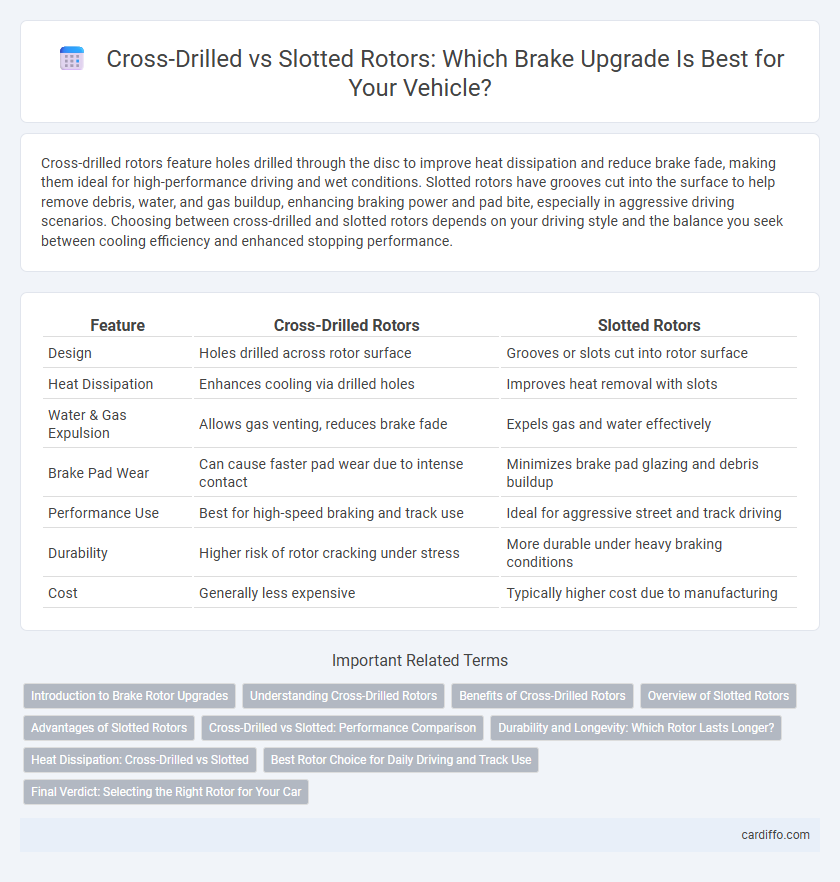Cross-drilled rotors feature holes drilled through the disc to improve heat dissipation and reduce brake fade, making them ideal for high-performance driving and wet conditions. Slotted rotors have grooves cut into the surface to help remove debris, water, and gas buildup, enhancing braking power and pad bite, especially in aggressive driving scenarios. Choosing between cross-drilled and slotted rotors depends on your driving style and the balance you seek between cooling efficiency and enhanced stopping performance.
Table of Comparison
| Feature | Cross-Drilled Rotors | Slotted Rotors |
|---|---|---|
| Design | Holes drilled across rotor surface | Grooves or slots cut into rotor surface |
| Heat Dissipation | Enhances cooling via drilled holes | Improves heat removal with slots |
| Water & Gas Expulsion | Allows gas venting, reduces brake fade | Expels gas and water effectively |
| Brake Pad Wear | Can cause faster pad wear due to intense contact | Minimizes brake pad glazing and debris buildup |
| Performance Use | Best for high-speed braking and track use | Ideal for aggressive street and track driving |
| Durability | Higher risk of rotor cracking under stress | More durable under heavy braking conditions |
| Cost | Generally less expensive | Typically higher cost due to manufacturing |
Introduction to Brake Rotor Upgrades
Upgrading brake rotors enhances vehicle performance by improving heat dissipation and brake response. Cross-drilled rotors feature holes that reduce heat buildup and help evacuate gases, while slotted rotors use grooves to maintain pad surface cleanliness and prevent glazing. Choosing between cross-drilled and slotted rotors depends on driving style and environmental conditions, with performance and longevity considerations guiding optimal brake system upgrades.
Understanding Cross-Drilled Rotors
Cross-drilled rotors feature precision-drilled holes that enhance heat dissipation and improve braking performance by allowing gases and water to escape from the rotor surface. These rotors are ideal for high-performance vehicles and severe driving conditions, offering better cooling and reduced brake fade compared to standard solid rotors. However, cross-drilled rotors may be more prone to cracking under extreme stress, making their selection crucial for balancing performance and durability.
Benefits of Cross-Drilled Rotors
Cross-drilled rotors enhance brake cooling by increasing airflow through precisely drilled holes, reducing heat buildup and minimizing brake fade during intense driving. They effectively expel gases, water, and debris from the rotor surface, improving brake pad contact and consistent stopping power in wet or high-performance conditions. Their lightweight design contributes to reduced unsprung weight, enhancing vehicle handling and responsiveness.
Overview of Slotted Rotors
Slotted rotors feature precision-machined grooves that enhance brake pad bite and improve debris removal during braking, leading to increased stopping power and reduced brake fade. These rotors are ideal for high-performance driving and heavy-duty applications where heat dissipation and consistent braking are crucial. Their design promotes better gas and dust evacuation, maintaining optimal brake pad contact and extending overall rotor and pad life.
Advantages of Slotted Rotors
Slotted rotors provide superior heat dissipation by allowing gases and debris to escape more efficiently during braking, reducing brake fade under extreme conditions. Their design enhances pad bite and maintains consistent braking performance, particularly in aggressive driving or towing applications. Compared to cross-drilled rotors, slotted rotors offer increased durability and resistance to cracking, making them ideal for high-stress environments.
Cross-Drilled vs Slotted: Performance Comparison
Cross-drilled rotors excel in heat dissipation and reducing brake fade during high-performance driving by allowing gas and debris to escape through the drilled holes. Slotted rotors provide superior brake pad cleaning and water evacuation, enhancing wet-weather braking consistency and maintaining pad bite under extreme conditions. Performance comparison shows cross-drilled rotors offer better cooling, while slotted rotors deliver improved stopping power and durability, making the choice dependent on specific driving needs and conditions.
Durability and Longevity: Which Rotor Lasts Longer?
Cross-drilled rotors offer superior heat dissipation due to their perforated design, reducing brake fade during intense driving but are more prone to cracking under heavy stress, potentially reducing their lifespan. Slotted rotors enhance debris removal and maintain consistent braking performance with better structural integrity, contributing to increased durability and longer service intervals. For longevity, slotted rotors generally outperform cross-drilled rotors, especially in high-stress or daily driving conditions.
Heat Dissipation: Cross-Drilled vs Slotted
Cross-drilled rotors feature drilled holes that improve heat dissipation by allowing hot gases and moisture to escape quickly, reducing brake fade under intense conditions. Slotted rotors have machined grooves that channel heat and debris away from the rotor surface, maintaining consistent friction and thermal stability during heavy braking. While cross-drilled rotors excel in cooling, slotted rotors provide enhanced heat management and structural integrity, making them better suited for aggressive driving or track use.
Best Rotor Choice for Daily Driving and Track Use
Cross-drilled rotors excel in heat dissipation and quick water removal, making them ideal for aggressive track use where high temperatures build rapidly. Slotted rotors offer superior brake pad grip and debris removal, enhancing consistent performance and longevity during daily driving with occasional spirited runs. For combined daily driving and track use, slotted rotors provide a balanced upgrade with reliable durability and improved braking under varied conditions.
Final Verdict: Selecting the Right Rotor for Your Car
Cross-drilled rotors offer superior heat dissipation and improved wet-weather braking, making them ideal for high-performance vehicles used in spirited driving or track conditions. Slotted rotors excel at maintaining consistent braking by effectively removing brake dust, gases, and debris, which enhances pad bite and reduces fade during aggressive street driving or towing. Choosing the right rotor depends on your driving style and conditions: cross-drilled for enhanced cooling and wet performance, slotted for durability and consistent braking under heavy-duty use.
Cross-Drilled Rotors vs Slotted Rotors Infographic

 cardiffo.com
cardiffo.com